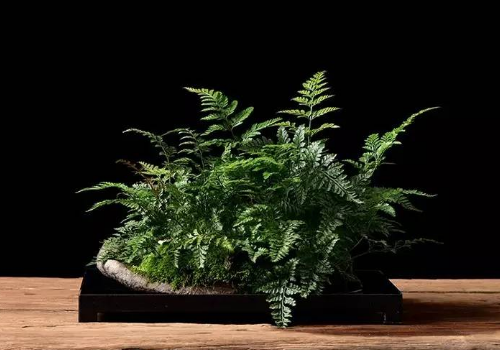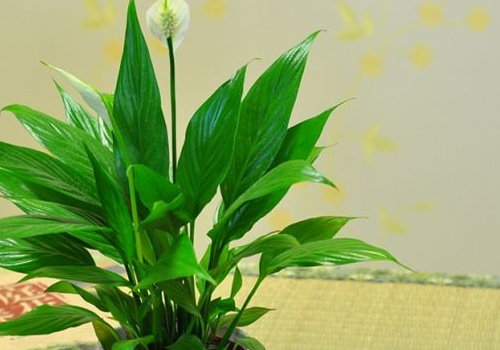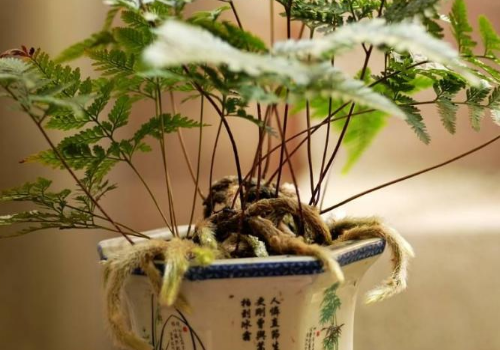Matters needing attention in how to raise Dryopteris vulgaris
Wolftail fern has a certain formaldehyde absorption effect, how to raise wolftail fern? Matters needing attention in culture:
How to raise Wolftail fern:
1. For breeding wolftail ferns, you can choose flowerpots, high pots or hanging orchids according to the needs of viewing, or you can choose some unique flowerpots, such as special snake pots or a section of rotten wood. The soil is mainly air permeable, which requires good drainage, and rotten leaf soil can be used.
2. Illumination: Dryopteris is an evergreen herbaceous epiphytic fern, which likes warm and semi-shady environment and is suitable for scattered light. It can not let direct sunlight, otherwise it is easy to wilt and curl. Family cultivation can be placed in a sunny place indoors.
3. Temperature: Wolftail fern originates from New Zealand and Japan, and is distributed in tropical and subtropical regions of Asia, Oceania, America and Pacific Islands. Dryopteris is not resistant to high temperature or cold. The suitable temperature is 20 ℃ ~ 26 ℃. The growth is poor when the temperature is higher than 30 ℃ or less than 15 ℃, and it should not be lower than 5 ℃ in winter.

Matters needing attention in the culture of Dryopteris Dryopteris:
1. Methods of reproduction. Dryopteris is a fern that has no seeds and usually propagates through spores. However, in general, family farming is propagated through cuttings, which is carried out in spring.
2. Diseases and insect pests. The main diseases in the growth process of Dryopteris are root rot, and the pests are mainly caused by aphids and red spiders, all of which are caused by environmental factors.
Have you learned the culture method of Wolftail fern?
Wolftail fern picture: how to raise Wolftail fern / how to breed Wolftail fern name: Dryopteris Dryopteris, Dryopteris Dryopteris classification: Fern families and genera: Pteridophyta, Pteridophyta, Dryopteris, Dryopteris. The rhizome is exposed, fleshy, about 6-12 cm long, with brown scales and hair on the surface, like rabbit feet, so florists call it rabbit foot fern or wolf tail fern. Dryopteris Dryopteris is a very popular indoor ornamental fern because of its graceful leaf shape, chic shape, high ornamental value of rhizome and leaf, and can also be planted on the rockery edge as a landscape plant. Its rhizome can also be used as medicine, which has the effect of dispelling wind and dehumidification, clearing heat and cooling blood. Introduction to the culture methods and matters needing attention of Dryopteris also known as Dryopteris Dryopteris and Dryopteris Dryopteris. The rhizome is exposed, fleshy, about 6-12 cm long, with brown scales and hair on the surface, like rabbit feet, so florists call it rabbit foot fern or wolf tail fern. Dryopteris Dryopteris is a very popular indoor ornamental fern because of its graceful leaf shape, chic shape, high ornamental value of rhizome and leaf, and can also be planted on the rockery edge as a landscape plant. Its rhizome can also be used as medicine, which has the effect of dispelling wind and dehumidification, clearing heat and cooling blood. Morphological characteristics of Dryopteris Dryopteris also known as Dryopteris Dryopteris and Dryopteris Dryopteris. The rhizome is exposed, fleshy, about 6-12 cm long, with brown scales and hair on the surface, like rabbit feet, so florists call it rabbit foot fern or wolf tail fern. Is a small epiphytic fern. The fern plant is 20-25 cm tall, the rhizome is long and transverse, densely covered with velvety lanceolate gray-brown scales. Leaves distant, leaf blade broadly ovate-triangular, 3-4-pinnately compound. The sporangia are born at the top of the veinlets near the leaf margin, and the cover of the sporangium is nearly round. Wolftail fern leaflets are fine oval or pinnately lobed leaves, leathery, smooth dark green, glossy, feathered leaves 10-30 cm long, supported by slender petioles, petiole slightly darker, 10-30 cm long. The ecological habit of Dryopteris Dryopteris is neither high temperature nor cold. The suitable temperature is 20 ℃ ~ 26 ℃. The growth is poor when the temperature is higher than 30 ℃ or less than 15 ℃, and it should not be lower than 5 ℃ in winter. The main points of cultivation techniques of Dryopteris is an evergreen herbaceous epiphytic fern, which is suitable for scattered light and can not let direct sunlight, otherwise it is easy to wilt and curl. Family cultivation can be placed in a sunny place indoors. Watering wolftail fern should keep the basin soil moist, and there should be sufficient water supply in the growing season, which can be watered once every 2 to 3 days. Although it is necessary to keep the soil moist, there is no harm in slightly drying during the watering interval for Dryopteris. Wolftail fern can not be watered too much, too much water can lead to leaf shedding. Dryopteris Dryopteris originated from New Zealand and Japan, and is distributed in the tropics and subtropics of Asia, Oceania, America and the Pacific Islands. The air humidity likes the high humidity environment and is not resistant to dryness. During maintenance, water should be sprayed frequently to the plant and growth environment. The appropriate humidity is about 80%. Too dry will cause leaf edge withering and yellow, or even the whole leaf withering and yellowing. Loose and breathable sandy loam is the best soil and fertilization soil. Dryopteris fern has a low demand for fertilizer and does not like concentrated fertilizer, so it can apply less thin fertilizer in the process of conservation. How to raise the balcony of Dryopteris Dryopteris the balcony of the family before Dryopteris is generally closed, and the glass after closure will isolate most ultraviolet rays, which is extremely disadvantageous to positive flowers. The wolf tail fern, a kind of fern with high ornamental value and likes the shady and wet environment, is very popular because it can grow healthily in the closed balcony. The stem of Wolftail fern is stout and walks close to the ground, dragging it all the way to the outside of the flowerpot. Stem dense pine needle-shaped, grayish brown, similar to animal hair scales, like a wolf's tail, hence the name. There are also leaves on the stem, but sparse; the petiole is about 9 cm long, and the leaf blade is broadly ovate-triangular, 10-15 cm long and 15 cm wide, slightly like asparagus, arranged in a feather. It has many aliases, such as white-haired snake, white-haired silkworm, hairy stone egg, round cover Yin stone fern and so on. The light on the closed balcony can meet the needs of Wolftail fern, preferably on the north side in summer and on the south side in winter. If the air is dry, spray to the leaf surface. Pot soil can be used with humus-rich and well-drained saprophytic soil, such as some carbonized bark is better. During the growing period, sufficient water is required, and thin fertilizer and water dominated by rotten organic nitrogen are applied once or twice, and low concentration foliar fertilizer can be sprayed at the same time. Some leaves turn yellow in summer and need to be removed in time to facilitate the regeneration of new leaves in autumn. The suitable temperature for its growth is 21-26 ℃ in daytime and 10-15 ℃ at night, and the room temperature should not be lower than 5 ℃ in winter. Ferns do not blossom and bear fruit and reproduce by conidia, but small families do not have to collect spores and cut them. In spring, the fern rhizome with 2-3 leaves or leaf buds is cut into small segments of about 10 cm, shallowly buried in the topsoil of humus and maintained in humidity, and new roots can be formed in about 40 days. Wolftail fern has wild plants in East China, South China, Southwest China and other places, which are attached to tree trunks and wet rocks near water, and can be dug and raised. Cultivation is usually planted in pots or hanging baskets. The most chic is raised in a special snake flowerpot, the plant will flourish and prosper. If there is no snake wood basin, it is also appropriate to choose a section of rotten wood with beautiful shape. The method of reproduction of Dryopteris Dryopteris: cut off the top part of the rhizome with 2-3 leaves, put it in a mixture of peat or perlite and sand, place it in a warm, semi-humid environment, and fix it with wire and other things. after moisturizing for about a month, new leaves and roots can be grown, or they can be propagated under high pressure. Although it is necessary to keep the soil moist, it is OK to dry slightly during the watering interval, and too much water will turn the scales on the rhizome brown. The common diseases and insect pests of Dryopteris Dryopteris are aphids, red spiders and root rot. Aphids, red spiders caused by poor environment, the effective ingredient 1% methylaminoavermectin 2000 times to control root rot, 80% mancozeb 1000 times, or 2% Ningnanmycin 1000 times, brassinolide and tetramycin mixture: 2000 times: 1500 times control. The function and ornamental value of Dryopteris Dryopteris is slow-growing, with brown rhizome scales, semi-hardy, planted in a high basin or hanging basket, silvery white stolon drooping, graceful leaf shape, chic shape, rhizome and leaf have high ornamental value, it is a very popular indoor ornamental fern; it can also be planted on the rock edge of rockery as a landscape plant, or as a moss micro-landscape matching plant. Wolftail fern is a green plant with graceful leaves and free and easy shape like a teenager in a green shirt. Wolf tail pouting has a high ornamental value and is a favorite indoor ornamental plant for many people. The garden use of Dryopteris Dryopteris can also be seen in many parks as a landscape plant beside rockery. The Dietotherapy or Medicinal value of Dryopteris Dryopteris the medical information and health dietotherapy information of Dryopteris fern are only for reference and can not be used as the basis of diagnosis and medical treatment. Any health problems should consult professional health care personnel, the treatment of any disease, please follow the doctor's advice. The ultimate task of protecting flowers: to love yourself, proceed from reality and follow the doctor's advice. For disease, do not be careless, do not postpone, do not give up hope, face it bravely, warm the silent world with love, and protect the inner flower field with your heart. Medicinal value Wolftail fern rhizome can also be used as medicine, with the effect of dispelling wind and dehumidification, clearing heat and cooling blood. The cultural background name of wolftail fern comes from the bare stem of wolftail fern, covered with brown scales and hair, like rabbit feet, so florists call it rabbit foot fern or wolf tail fern. The flower language of Wolftail fern: narcissism. Can Dryopteris vulgaris be cultured in hydroponics? cultivation techniques of Dryopteris Dryopteris
Dryopteris Dryopteris is a very popular fern in the market at present, and its ornamental value is very high. If home farming can be made into a miniature landscape, it can also be made into a gondola and placed indoors or on the balcony. However, in the past, the way of soil cultivation can no longer meet the needs of people, and the gradual introduction of hydroponic potted plants is more attractive, not only simple and convenient, but also clean and beautiful. Many people will ask, can Wolftail fern also be hydroponically cultivated?
Can Dryopteris vulgaris be cultured in water?
I. production preparation
A healthy wolf tail fern, a planting basket, a transparent flowerpot for easy observation of water, the right amount of cotton, non-woven cloth and colored stone.
Second, the production process
1. Production of planting basket
The cotton is spread at the bottom of the planting basket and covered with a layer of non-woven cloth to maintain the water supply of the plant during the culture process. The cotton thread passes through the bottom of the planting basket to fix the roots of the plant.
2. Hydroponic Dryopteris Dryopteris
If you rinse the wolf tail fern in water, you can trim the roots properly, and if you trim, you should pay attention to drying the wound. Put the plant into the planting basket and fix it with cotton thread to avoid falling down. It is covered with non-woven cloth and decorated with colored stones. Such a refreshing aquatic wolf-tail fern has been made.
3. Later maintenance of Dryopteris Dryopteris in water culture.
Put the wolf-tail fern in the half-shade to slow the seedling for about a week, and then culture normally after the whole plant comes back to life. Remember to always pay attention to the change of moisture in the basin, and if less, remember to replenish water in time.
Change the water in the basin every two weeks, pay attention to clean up the moss in the basin; if you like, you can raise a few small fish in the transparent basin below, which can eat the substances secreted by plant roots and metabolic waste, increase ornamental and clean the water in the basin at the same time.
Cultivation techniques of Dryopteris vulgaris
1. Lighting
Dryopteris is an evergreen herbaceous epiphytic fern, like a warm semi-shady environment, suitable for scattered light, can not let direct sunlight, otherwise it is easy to wilt and curl. Family cultivation can be placed in a sunny place indoors.
2. Watering
Wolftail fern should keep the basin soil moist, and there should be an adequate supply of water in the growing season, which can be watered once every 2 to 3 days. Although it is necessary to keep the soil moist, there is no harm in slightly drying during the watering interval for Dryopteris. Wolftail fern can not be watered too much, too much water can lead to leaf shedding.
3. Temperature
Wolftail fern is native to New Zealand and Japan, and is distributed in tropical and subtropical regions of Asia, Oceania, America and the Pacific Islands.
4. Air humidity
Like high wet environment, not resistant to drying, during maintenance should frequently spray water to the plant and growth environment to humidify, the appropriate humidity is about 80%, too dry will cause leaf edge withered yellow, or even whole leaf withered yellow.
5. Soil and fertilization
Loose and breathable sandy loam is the best soil. Dryopteris fern has a low demand for fertilizer and does not like thick fertilizer, so it can apply less thin fertilizer in the process of conservation.
What are the points for attention in breeding wolf tail fern?
1. Methods of reproduction
Dryopteris is a fern that has no seeds and usually propagates through spores. However, in general, family farming is propagated through cuttings, which is carried out in spring.
2. Diseases and insect pests
The main diseases in the growth process of Dryopteris are root rot, and the pests are mainly caused by aphids and red spiders, all of which are caused by environmental factors.
Why the leaves of Dryopteris fern turn yellow and wither
1. Lack of water at the root
Soak the flowerpot in the water container. See that the surface of the basin soil is wet, take the basin out. I master it every time I water it. Cut off the dry leaves.
2. Improper lighting
Although the wolf tail fern is shady and does not like strong light, the growth conditions must also have a certain amount of light, preferably with semi-shade maintenance, not in too shady places, let alone direct light in summer.
3. The air humidity is too low
Not only like water, but also like the wet growth environment, in addition to normal watering, but also frequently spray water to the plant to maintain good growth.
4. Fertilizer surplus
The demand for fertilizer is not high, do not like thick fertilizer, as little as possible.
From the above, we know that Wolftail fern is also suitable for hydroponic culture, which is undoubtedly not good news for most people. Whether hydroponic or soil culture, the breeding method of Wolftail fern is not very difficult, so flower friends with ideas might as well give it a try.
- Prev

Plain sailing. When? what's the ramet method?
Plain sailing, this is also a kind of plant, is super many people know, so plain sailing when to plant? What is the ramet method: plain sailing when to ramet: plain sailing can be used for ramet and sowing and reproduction. A robust plant can be divided into one plant every two years.
- Next

Can Wolftail fern be put in the indoor bedroom? can it be hydroponically cultured?
The market price of wolftail fern is not as expensive as other plants, and it is still very close to the people. Can Wolftail fern be put in the indoor bedroom? Can it be hydroponically cultured: can Wolftail fern be put in the indoor bedroom? it will do no harm to the human body. Wolftail fern can be placed next to coffee tables and printers.
Related
- Fuxing push coffee new agricultural production and marketing class: lack of small-scale processing plants
- Jujube rice field leisure farm deep ploughing Yilan for five years to create a space for organic food and play
- Nongyu Farm-A trial of organic papaya for brave women with advanced technology
- Four points for attention in the prevention and control of diseases and insect pests of edible fungi
- How to add nutrient solution to Edible Fungi
- Is there any good way to control edible fungus mites?
- Open Inoculation Technology of Edible Fungi
- Is there any clever way to use fertilizer for edible fungus in winter?
- What agents are used to kill the pathogens of edible fungi in the mushroom shed?
- Rapid drying of Edible Fungi

